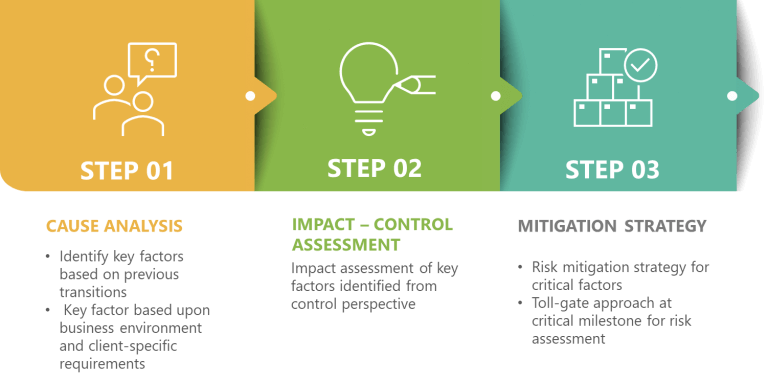This website uses cookies. By continuing to browse the site, you are agreeing to our use of cookies
Going Green – The Strategy for Optimally Efficient Processes
Business Process Services
September 23, 2020
Delivering remarkable business results in the digital era is a challenging responsibility. The rapidly evolving business environment with digital technologies, social media and automation impacting all spheres of business has fixated on end customer satisfaction as the highest priority for all . Clients are focused on minimizing disruption to their business processes and subsequent minimal or nil impacts on end customers while transitioning processes to Service Providers. Due to this increased emphasis on minimizing impact for end customers, “Day-1 Go Green” strategy has become a critical consideration for clients while outsourcing their processes.
The Hexaware approach focused on “Day – 1 Go Green” ensures that the migration of processes does not have any impact on drivers critical for clients’ businesses and their end customers. Hexaware leverages its robust Transition framework “TransX” that has been used to deliver over 500 business transitions successfully, to deliver “Day 1 Go Green” transitions successfully. TransX methodology recognizes the fact that every transition is different with its unique business needs and the approach is customized to meet the client-specific requirements.
Approach for achieving Day-1 Go Green
A three-step implementation approach is recommended in ensuring Day-1 Go-Green. This approach has been created from the experience of handling transitions across multiple verticals, business scenarios and geographies at Hexaware:

The three-step approach given above is supported by a robust governance framework to track and review risks as a part of regular transition governance with key internal and external stakeholders.
The first step of this approach is to identify all potential factors that can impact quality, timelines and cost of the transition deliverables. This is done in a structured manner in “Cause Analysis”.
Step 1: Cause Analysis
As a part of transition planning, a cross-functional Project Team consisting of key internal stakeholders captures “What went right” and “What could have been done better” across all phases of transition based on prior experience in handling similar transitions. This analysis provides insights into potential factors that could impact a successful “Day-1 Go Green” scenario for a given transition.
A typical analysis by this cross-functional team would identify parameters in key areas that could impact the transition including:
- Project scoping and sizing based on information provided by client
- Overall project planning from People, Process, Technology and Legal perspectives
- Analyzing resource skill profiles and hiring
- Knowledge transfer approach for the project
- Technology solution requirements
- Specific transformation solutions to be incorporated as a part of transition
These parameters are then analyzed further using Fish-Bone analysis framework with key internal stakeholders. An illustration of the type of analysis that is done by this cross-functional project team as a part of this step has been provided in the figure below:
Parameters Affecting Day-1 Go-Green
Figure below (Fishbone – Root Cause Analysis) illustrates parameters impacting Go Green on production Day-1 with the help of Fish-Bone Analysis.

The diagram effectively captures the potential root-cause obstructions to a seamless and slippage free transition.
To understand the impact of these parameters a detailed Impact-Control matrix is created as the next step.
Step 2: Impact-Control Assessment
Impact – Control Assessment is designed to assess impact of potential root causes affecting Go-Green from Day-1 with respect to the partner’s sphere of control for the impacting parameters identified.
The impact of factors is classified into three categories – high, medium and low depending upon the severity of impact. The severity of impact is decided by the influence a particular factor can have on the proposed transition timelines, quality and deliverables. A typical classification of the factors has been provided below:
- High Impact: All root causes causing severe impact on Day-1 Go Green plan directly
- Medium Impact: All root causes which are not yet impacting the transition deliverables and timelines – but need to be monitored closely to ensure that appropriate mitigation plans are implemented
- Low Impact: All root causes which need to be addressed but will not impact the project timelines/ final project outcome
These are then also classified into two categories:
- In Control: Partner can control the cause by taking effective mitigating actions internally
- Out of control: Partner can only track the timely completion of these activities but cannot influence the timelines required to complete these activities.
The following table is an illustrative “Impact – Control Matrix” that is prepared during the project transition phase:

After creating “Impact Control Matrix”, the Project team works with appropriate internal and external stakeholders to create mitigation strategies for each of the factors.
Step 3: Mitigation Strategy
Defining and implementing an effective mitigation strategy for “In control” and “Out of control” factors is the final step in this process. At Hexaware, we believe in a pre-emptive approach rather than reactive approach for risk management during transitions.
The mitigation strategy for different parameter types is elaborated below:
- Mitigation Strategy for “In Control” Parameters
Regular reviews of “In control” transition risks with internal stakeholders and with clients ensures implementation of appropriate mitigation measures for these risks.
Right from project inception, a risk and issue log to be maintained by Transition Manager. This risk and issue log should be reviewed regularly with all relevant stakeholders to take appropriate mitigating actions
The risks should be proactively called out during Transition Governance meetings and reviewed with internal and Client stakeholders, to highlight the roadblocks and ensure that appropriate mitigation measures are implemented to avoid any impact on project objectives and plans.
- Mitigation Strategy for “Out of Control” Parameters
“Out of Control” parameters such as access to client applications, client-specific background verification requirements or specific information security certification requirements are transition-specific and vary depending upon client business environments.
To manage “Out of control” factors, it is critical to identify all these factors at the beginning of transition and to define an acceptable timeline for the completion of these activities along with clients. This timeline is then incorporated in the transition plan.
For “Out of Control” factors, emphasis is on completing all the input activities in a timely manner to meet the timelines. Tracking timely completion of input activities becomes critical and any delay in completion of input tasks is highlighted immediately to the relevant stakeholders.
Rigorous monitoring and highlighting of risks in a timely manner since project inception builds a clear road map and aligns all the relevant stakeholders to project scope and desired outputs from the very beginning.
Key Enablers
“Day-1 Go Green” initiative can ideally be implemented by two key enablers – Robust Governance and Leveraging technology.
- Robust Governance
Project governance is the framework within which critical project decisions are made. Robust governance helps in driving effective communication and speedy resolution of issues.
At Hexaware, we have a robust multi-level governance model that takes into consideration projects of all domains, business models and complexities. A detailed and well-defined Responsibility Assignment Matrix (RACI), detailed meeting and review cadence enables discussions at multiple levels. Effective management of project risks and monitoring of change requests forms the broad outline of an effective governance model.
- Leveraging technology
Technology has become an integral part of the transitions and it plays a significant role in different phases of transition.
Process discovery /Process mining tools could be leveraged for process mapping, data baselining and to identify transformation and process improvement opportunities.
Further, usage of knowledge capture tools available and learning management platforms during knowledge transfer can significantly improve the quality and efficacy of the documentation captured/created as well the knowledge transferred. At Hexaware, we use BOTs/dashboards for reporting, to help expedite the MIS reporting processes thereby providing a visibility of operations performance from the very first day of go-live. Usage of these technology enablers would contribute significantly in the endeavor to deliver “Day-1 Go Green”.
Go Green and Reimagine Productivity
With changes in the overall business environment and client expectations about process outsourcing, “Day 1 Go Green” is emerging as a critical criteria to ensure client satisfaction. Clients are becoming increasingly aware and concerned about the impact that challenges in service delivery will have on their businesses, end customer experience and revenues.
While business requirement of each client differs, our approach on treating each customized offering with the best we have to offer, by analyzing the needs through comprehensive process and business assessment and then formulating the solutions based on the understanding of the business risks specific to the client has proven Hexaware’s 3-step approach to drive “Day 1 Go Green” highly effective.
Related Blogs

From Manual to Machine: Maximizing Cost Savings with Intelligent Process Automation
- Business Process Services

Achieving Cost Efficiency Through Global Business Services Strategy
- Business Process Services

Generative AI for Marketing: The Future of Cost-effective Engagement
- Generative AI
- Business Process Services

Unlocking Generative AI for Hyper-personalized Customer Experiences
- Generative AI
- Business Process Services

Executive Administration Services: BFSI’s Right-hand Partner
- Generative AI
- Business Process Services

Generative AI in Customer Service: Going Beyond Traditional Chatbots
- Generative AI
- Business Process Services

Generative AI for Content Creation: The Future of Content Ops
- Business Process Services
- Generative AI
Fund Services Back Office Digitalization: A Transformation Long Overdue?
- Business Process Services

Mastering Customer Service Experience: Strategies for Success
- Business Process Services

The Rise of Omnichannel Customer Service: Unlocking Excellence in Customer Care
- Business Process Services

Ready to Pursue Opportunity?
Every outcome starts with a conversation








